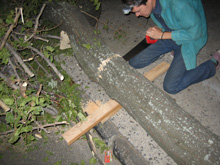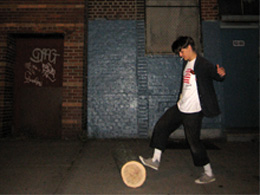 
As we were closing up shop at Tools for Working Wood the other night (a few months ago) the lights flickered, and the sky turned green. Suddenly, we were blasted by gale force winds and rain so thick we couldn't see past the window panes. The storm was over as quickly as it began, and ten minutes later we turned out the lights and I got on my bike to ride home. What I had assumed was a short squall turned out to be a tornado! I rode past tipped-over lamp posts, an overturned Semi-trailer, destroyed store awnings, and felled tree after felled tree. It was a surreal scene, and as I slowly pedaled home weaving my bike through stopped traffic and around misplaced gates, fences, and stray branches, I got to thinking about green woodworking, rived lumber, and how to get a log home without a car.
Lucky for me, a block from my apartment laid a tree torn out of the ground, pushed by sanitation workers to the side of the road. I'm no botanist, but it looked to me like a little-leaf linden. The trunk was about 16 inches diameter, fairly straight and knot-free up until it split out into the branches. The projects I have planned (a small viking ship and a lamp) don't demand huge boards; 4 feet of trunk should be enough. A friend came over to help me with the operation. In typical style, I didn't plan very well and forgot to take the biggest saw I could find from TFWW. The tools we have to work with: an 18 inch hand saw from Sears, a headlamp, and some scrap 2x4's for blocking up the trunk to keep the saw from binding. Lumberjacks we are not.
1 hour later:
A second friend on her way home stops to heckle/watch/saw/photo and after an hour the three of us finish the two cuts. Rolling the trunk home along the sidewalk was easier than I expected. Taking it up two flights of stairs... well, it got there. We might not have exuded the breezy ease of Roy Underhill striding into the forest with his single buck saw and banjo music in the background, but we got the job done, and now I've got genuine New York City street wood to split into boards.
My plan of attack was to use a froe to split off the sap wood to leave the heartwood, which I'll split into pieces for seasoning. My most relevant training is vague memories of splitting firewood.
How the Froeing is Going:
My first step was to use a draw-knife to skin off all the bark. Next, I tried to drive the froe into the end grain to begin a split. This was where my trouble began, but not where it ended. I drove the froe into a corner of the end grain. It got wedged and wouldn't drive any further. I used the handle to leverage it out and sawed a kerf into the trunk to start the froe. This allowed me to get the froe stuck, but not to split the wood.
In the lead up to this exercise I did a small amount of research into tree splitting technology. My most interesting find: black powder log splitting. A more reasonable/boring solution came from A Museum of Early American Tools by Eric Sloan which illustrates a wooden splitting wedge. I made four of them out of some hard maple I've had sitting around for ages. I pounded one into the kerf/dent left by the saw/froe. It got wedged in, but still wouldn't start the split. My last resort was to drive a chisel up to its hilt into the log. Oops. I tried to free the chisel with a maple wedge. I tried different wedges in different combinations. I tried to put the froe back in. I tried hammering until I had destroyed the chisel, and nearly taken off a finger trying trying to pound in a spike.
Obviously, I was under-equipped (aka out of black powder), but in a last ditch effort to accomplish something I sawed off a foot and a half section of a 6 inch diameter log from the same tree. I drove the froe into the log, pulled back and the wood split! I split off the sapwood, and very generally shaped the log into a rectangle to split into boards. I found the froe to be most effective when pounded into the end of the log to bury the blade and then leveraged, rather than pounded, to split off "boards." I'm not a master froer, but I got more effective with the tool as I kept splitting off sections. If I had planned a little better, and trusted the froe I think I could have gotten two or three more boards out of the wood, and oriented the grain more effectively.
Using the froe left me thinking how much different it is to split wood rather than saw, chisel or plane it. Using it to rough out forms was a lesson in subservience to nature. I guess that's fitting-- it was a tornado that put this whole project in motion. |
 Joel's Blog
Joel's Blog Built-It Blog
Built-It Blog Video Roundup
Video Roundup Classes & Events
Classes & Events Work Magazine
Work Magazine















I've also experienced getting tools stuck in logs that just don't want to split...
You've more background than most do with your education. Interesting, bold, approach grabbing some free wood.
I have done things for years with wood from discarded furniture and skids. Some beautiful woods in skids. Finally dried 'flat' but often toxic. I control that by working it with hand tools and a hepavac.
Can't wait to see what you produce.
keep at it.
And yep, it was the 16 September Tornados
Looking forward to future posts into the adventures of city woodworking.
Rock on.
Great start, looks like fun. Actually, it looks like it must have been frustrating as hell....as well as fun! For green woodworking tools, techniques, etc., I can't recommend strongly enough the blogs by Peters Follansbee (<http://pfollansbee.wordpress.com/>) and Jennie Alexander (<www.greenwoodworking.com/>).
Good luck with your adventures...there's nothing like making something from found wood...especially when it's green and friendly to work with!
Cheers,
Derek
Couple of your photos show the froe going in at an angle to the cut end of your log. Maybe you already know this but the froe needs to be pounded in with the blade sitting flat on the end grain. Bravo for splitting out the boards without a cleaving brake.
http://www.greenwoodworking.com/RivingArticle
This is awesome/hilarious!
It's like as if you pause in the intro of the Woodwright's Shop (the bit where he's booking it out of the city) and you would be in the background (behind the car crash)riving boards!
Great start to the blog and looking forward to reading more.
Cheers,
Niels
Then use the froe to split off your boards.
Wedges are in the works just as soon as the back forty thaws.
No I don't think chainsaws are illegal, although a friend of mine carrying around an axe spent some time chatting with the NYPD
Love,
J
Never heard of anyone using s froe for splitting that wood. Froes are designed for straight grained woods such as oaks, ash, chestnut, hazelnut and cedar. Your a brave man!
I'm just getting in to fine woodworking but in my younger days I cut and split a heck of a lot of firewood. Now I often dream "what if" when I think back of all the oak, ash, hickory, cherry and even walnut we cut and sold for fireplaces. That was a long time ago.
If you ever try to split green timber by hand again, one tip is to only do it when it is frozen solid. That goes especially for any wood your not sure how well it splits.